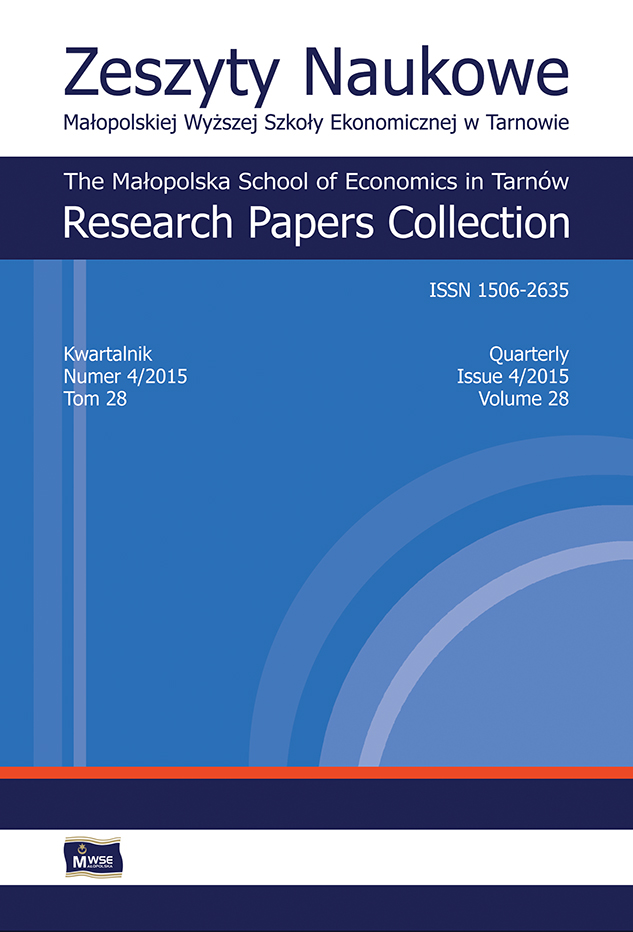Abstract
The aim of following work is to present the level of management and labour productivity indicator as tools of assessing the work of company administration and its effectiveness as a whole. These indicators have been derived from production function whose form reflects the natural process of composing generative factors. These factors include traditionally understood assets and human resources. Consequently, the applied production model uses both the data of traditional calculation of costs and the calculation of human capital, which is a very dynamically developing area of economical science. Additionally, this model allows assessing the contribution of human capital in the economical effect of an enterprise, and consequently enables determining the level of remuneration of the human capital. The latter functionality, together with the theory of basic salary adequate to the value of individual human capital, is the basis for the system of bonuses based on financial effects of a unit. The above assumptions have been verified in the work on the basis of a practical example.
References
Armstrong, M. (2007). A handbook of employee reward management and practice. London: Kogan Page. ISBN 9780749449629.
View in Google Scholar
Blaug, M. (1995). Metodologia ekonomii. Transl. by B. Czarny. Warszawa: Wydawnictwo Naukowe PWN. ISBN 8301116471.
View in Google Scholar
Bliss, C. (2005). The theory of capital: A personal overview. In: C. Bliss, A. Cohen, G. C. Harcourt (eds.), Capital theory. Cheltenham: Edward Elgar. ISBN 1840644818.
View in Google Scholar
Dobija, D., Dobija, M. (2003). O naturze kapitału. Zeszyty Teoretyczne Rachunkowości, 17(73). Warszawa: Stowarzyszenie Księgowych w Polsce, Rada Naukowa.
View in Google Scholar
Dobija, M. (2004). Analityczna funkcja produkcji, cz. 2. Ekonomika i Organizacja Przedsiębiorstwa, 40(11), 9–16.
View in Google Scholar
Dobija, M. (2011). Labor productivity vs. minimum wage level. Modern Economy, 2(5), 780–787.
View in Google Scholar
Dobija, M. (2012). Political reforms based on a Human Capital Research Programme. Argumenta Oeconomica Cracoviensia, 8, 9–29.
View in Google Scholar
Hulten, Ch. R. (2000). Total factor productivity: A short biography. National Bureau of Economic Research Working Paper, 7471, January.
View in Google Scholar
Humpherey, T. M. (1997). Algebraic production functions and their uses before Cobb-Douglas. Federal Reserve Bank of Richmond Economic Quarterly, 83(1), 51–83.
View in Google Scholar
Kozioł, L., Kozioł, W., Wojtowicz, A., Pyrek, R. (2014). An outline of a compensation system based on human capital theory. Procedia—Social and Behavioral Sciences, 148, 551–558.
View in Google Scholar
Lavoie, M. (2001). Capital reversing. In: P. A. O’Hare (ed.). Encyclopedia of political economy. Vol. 1: A–K (pp. 58–61). London and New York: Routledge. ISBN 0415241863.
View in Google Scholar
Manuelli, R., Seshadri, A. (2007). Human capital and the wealth of nations [online, accessed: 2015-11-20]. Madison: University of Wisconsin. Retrieved from: http://citeseerx.ist.psu.edu/viewdoc/download?doi=10.1.1.73.9308&rep=rep1&type=pdf.
View in Google Scholar
Mishra, S. K. (2007). A brief history of production functions [online, accessed: 2015-11-20]. MPRA Paper, 5254. Retrieved from: https://mpra.ub.uni-muenchen.de/5254/1/MPRA_paper_5254.pdf.
View in Google Scholar
Robinson, J. (1953). The production function and the theory of capital. Review of Economic Studies, 21(2), 81–106.
View in Google Scholar
Romer, D. (2000). Makroekonomia dla zaawansowanych. Warszawa: Polskie Wydawnictwo Ekonomiczne. ISBN 9788301167691.
View in Google Scholar
Sahinidis, A. G., Kavoura, A. (2014). Exploring Corporate Social Responsibility practices of Greek companies. Zeszyty Naukowe Małopolskiej Wyższej Szkoły Ekonomicznej w Tarnowie, 25(2), 185–193.
View in Google Scholar
Wetzstein, M. E. (2013). Macroeconomic theory: Concepts and connections. Abingdon and New York: Routledge. ISBN 9780415603706.
View in Google Scholar
© Copyright by Małopolska School of Economics in Tarnów. The articles are available under the Creative Commons Attribution NonCommercial-NoDerivatives 4.0 International License


